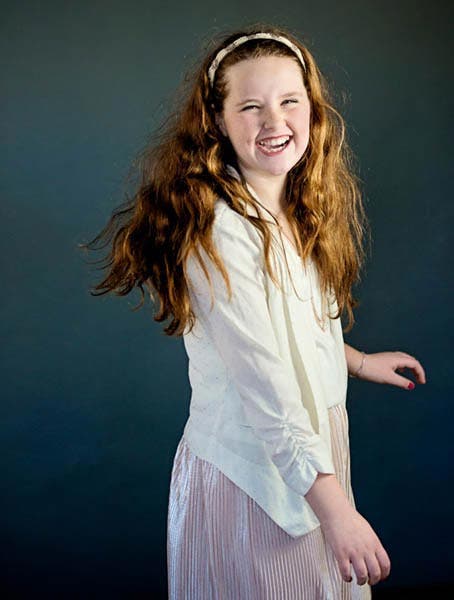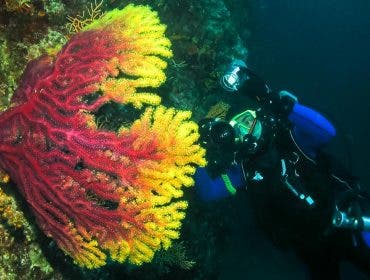One of the more frequently asked questions related to studio photography lighting is this: Do you prefer continuous lighting or strobe-light photography? The answer to that question has changed over the years of shooting portraits in the studio, due to changes in technology and changes to my shooting style.

Let’s kick off with some simple definitions of photography lighting.
What is continuous lighting in photography?
Continuous lighting in photography occurs when you turn the studio lights on, they stay on – like a video light or a flashlight. You can power your studio lighting up or down, based on what you need, but they produce What You See Is What You Get lighting. Assuming you expose everything correctly in camera, what you see before you will be the lighting you capture in the frame. Exactly how you light the scene (and the individuals in the scene) will photograph just like what you see before you click the shutter.
What are the benefits of continuous lighting?
Continuous lighting is a fantastic choice for a variety of reasons.
First, if you plan to shoot with multiple cameras or you’ll have an assistant shoot while you work as the primary shooter, continuous lighting will allow you to photograph simultaneously without interfering with each other’s lighting.
With continuous lighting, you don’t need to worry about external lighting components like triggers. That means you can get your shoot set up quickly and easily regardless of how many cameras you intend to use.
Continuous lighting for photography is also a major benefit if you’re considering shooting any behind-the-scenes footage or video content. Strobes can be problematic when a videographer is working alongside the photographer. Choosing continuous lighting keeps things far more flexible in that case.
Finally, continuous lighting is wonderfully predictable. What you see is what you get, and you don’t have to worry about missing a shot because of a flash misfire or sync-speed mishap.
What is strobe lighting in photography?
Strobe lighting is just like flash: it lights up when you trigger it and needs a bit of time to recycle so that it can be fully powered for the next shot. You cannot see exactly how your scene will be captured until you trigger the flash. Once you do, a high-intensity light will pulse for just a fraction of a section, lighting the scene as you hopefully expected when you positioned — and set the specifications — for your lights.
What are the benefits of strobe lighting?
Let’s take a look at strobe lighting’s benefits.
Brighter
Strobe lighting is generally much brighter than continuous lighting. As a result, you can shoot at faster shutter speeds so you can freeze your subject’s motion without needing to sacrifice depth of field or boost your ISO.
Convenient
Working with strobe-light photography is also convenient because it’s easier to dial in your white balance for color consistency from shot to shot. Just select Flash as your white balance in-camera. All the resulting photos will remain consistent for easier post production.
Less Heat
Working with continuous lighting for long periods of time can introduce heat into the studio. Over time that heat can cause discomfort for you and your subject and can also require hair, makeup, and wardrobe adjustments. Because strobes fire for only a fraction of a second, they don’t create as much heat in the studio.
Simple Modifications
Finally, strobe lighting is easier to modify. There are far more modifiers like umbrellas, snoots, softboxes, and beauty dishes available for strobe lights than for constant lights.

Continuous lighting vs strobe lighting – which is right for you?
Like many other things in photography, the cost and level of investment may be a major consideration for you when deciding between continuous lighting and strobe lighting equipment. Both are great choices for photography lighting, but one option may be more affordable or practical for you than the other.
Strobe lighting tends to be more expensive for the initial investment but holds up well with a limited decline in power or quality.
Continuous lighting for photography is less expensive to get started with. One downside is that the finished product may be less attractive, and fixtures may burn out more quickly because they’re used for longer periods of time.
Learning the equipment is an important factor, too. If you’re up for the challenge, consider trying your hand at strobe-light photography. The results are well worth the effort, and once you get the hang of the studio lights, you’ll achieve predictable results in every shoot.

Photography lighting equipment: a matter of personal preference
If you started shooting years ago, you may have only used strobe lighting because the technology behind continuous lighting was simply not there yet in terms of power. Also, the lights often became too hot to be safe around children, and the color of the lighting wasn’t always optimal, either.
Thankfully, the technology has improved greatly over the years, which is why some photographers use continuous lighting nearly exclusively in the studio. Why? First of all, today’s continuous lighting systems are more powerful and cooler to the touch — even if you leave them on for a long time. They now come in white-balance-friendly daylight fluorescents, too.
Also, if you spend a lot of time interacting with your subjects and encouraging them to move freely, the broad, constant lighting is actually quite nice — and you no longer need to worry about constantly adjusting them. Simply drag and reposition them as needed.
You may still find that strobes are more powerful than continuous lighting options, but here’s the thing: you may not always need the level of power they provide for every shoot. You may have great natural light in the studio, for example. Plus, you may have fantastic high-level ISO capabilities on your cameras.
For all those reasons, many photographers prefer continuous lighting over strobes more often for portrait sessions. To be clear, your choice depends on your style of shooting, in addition to the gift of natural lighting in your studio. Don’t forget that it will always be important for you to determine for yourself which method of lighting is best for you, based on your own specific situation.




